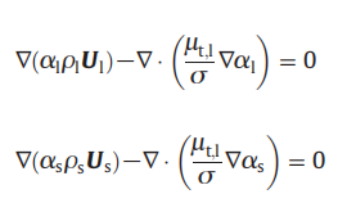reactingtwophaseeulerfoam?
-
@东岳 If I understand well, equation (24) was changed by the sum of two mass conservation equation. However I must add that term in the mass conservation equation. So the position I implemented the laplacian term is right? The mass conservation equation shown in picture is our own equation.
-
@东岳 Frankly, I use the minus sign and I got the results however they doesn't agree well with the results from PHOENICS. The velocity profile seems shift in some degree. So I would like to try "plus" this term. I am not sure the place I added is right or not. When I change one to be plus and the other to be minus, it runs well and the results seems better.
-
@东岳 Sorry. I am still confused that how the equation(24) mentioned in your page could be solved in OpenFoam. In the source code:
solve ( pEqnComp1() + pEqnComp2() + pEqnIncomp, mesh.solver(p_rgh.select(pimple.finalInnerIter())) );why
pEqnComp1() + pEqnComp2() + pEqnIncompranther than- pEqnComp1() - pEqnComp2() + pEqnIncomp. Because in your equation(24), pEqnComp1() + pEqnComp2() in the right side while pEqnIncomp in the left side. -
Thanks for your feedback. The R.H.S. of the following equation should be a
-sign. It was corrected.
\begin{equation}\label{comp_nablaU}
\underset{\mathrm{pEqnIncomp}}{\underbrace{\nabla\cdot\left(\alpha_\rd\bfU_\rd+\alpha_\rc\bfU_\rc\right)}}=\underset{\mathrm{\color{red}{-}pEqnComp1\color{red}{-}pEqnComp2}}{\underbrace{-\frac{\alpha_\rd}{\rho_\rd}\frac{\rD\rho_\rd}{\rD t}-\frac{\alpha_\rc}{\rho_\rc}\frac{\rD\rho_\rc}{\rD t} }}.
\end{equation}What is the first term? Its a second order tensor which is not consistent with the second term (scalar).

